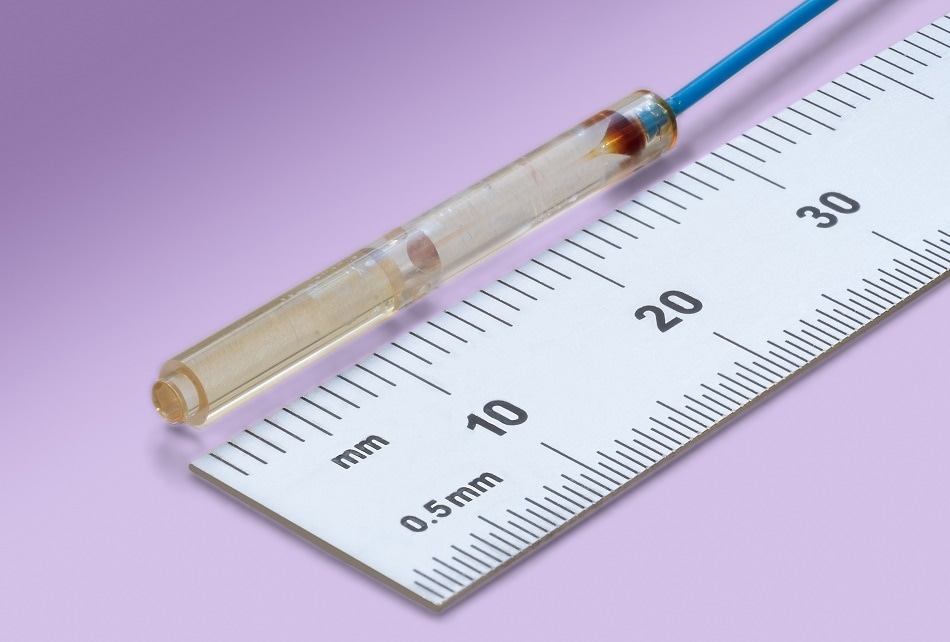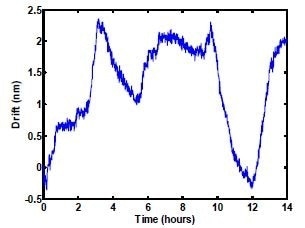This article provides a brief overview of precision measurements of sub-mm displacements and compares the relevant performance characteristics and limitations, followed by an in-depth analysis of a fiber-based, multi-channel interferometer system that integrates high-accuracy displacement measurement capability with absolute distance measurement over a range of 500 µm, with a displacement measurement uncertainty (k=2) of 4 parts per million.
Overview of Technologies
Sensors for the measurement of displacement based on a number of different physical principles are available for a wide range of applications. This article considers systems capable of resolutions of ~100 nm and below. From a review of commercially available systems, displacement sensors may be categorized into two broad categories: Type I, where range and resolution are not coupled and Type II, where they are. Some of the examples of Type I sensors include interferometric encoders and sensors, where the resolution is independent of the range of measurement, resulting in excessively high dynamic ranges (range/resolution). General Type II technologies include confocal devices, chromatic aberration-based sensors, triangulation-based devices, reflectance-based fiber sensors, and inductive (LVDT) and capacitive sensors. However, free-space interferometric sensors and encoders have numerous disadvantages when compared to Type II technologies. These disadvantages include the lack of an intrinsic means of establishing the distance of the target from the sensor and the ability to function as homing sensors without modification (supplementary home sensors, index marks, etc.). In addition, they tend to have relatively large sensor packages and in the case of interferometers need a complex arrangement of beam directing optics. Hence, for short-range displacements, Type II sensors are usually chosen, despite the active (heat dissipating) nature of many of these sensors. Fiber-based interferometric sensors include the best features of both classes of sensors and combine approximately large dynamic range and high resolution (characteristic of Type I sensors) with high-accuracy absolute distance measurement and high-precision homing (enhancing on Type II sensors). The usage of optical fiber results in a compact, passive, EMI immune sensor package.
Fiber-Optic Distance Sensor System
This section explains the performance of an experimental system as part of the authors’ research into solutions that address many of the drawbacks of Type I sensors and enhances many of the advantageous aspects of Type II sensors.
The system permits applications that need simultaneous measurement over short ranges of a multiplicity of channels (~60) at a bandwidth of many kHz [2]. The system architecture supports high system reliability, completely passive sensors, and low cost per channel by splitting the system into two parts: the sensors and the control unit. This focuses heat generating components and cost in the control unit, leaving the sensors completely passive, and reduces the incremental cost of adding channels.
Furthermore, all components that may need maintenance or replacement are in the control unit while the high-reliability sensors can be embedded within the application.
The sensors leverage commonly available telecom components in terms of cost, size, and reliability, resulting in highly compact (φ3 X 12 mm length as shown in Figure 1) and reliable sensors. Optical fiber connections confer flexibility on the routing and immunity to electromagnetic interference (EMI), as does the optical interference based operation of the sensor.
The system functions in two distinct modes: displacement measurement and absolute distance. In the absolute distance mode, as opposed to most displacement interferometer systems where the absolute distance of the target which is not known, the instrument finds out the distance of the target from the reference surface.

Figure 1. Image of sensor

Figure 2. Displacement measurement performance

Figure 3. Stability of absolute distance measurement
This provides the ability to return the target to a predetermined distance from the reference surface, i.e., a 'homing' functionality in the presence of momentary beam interruption and upon restarting the system. The displacement mode computes changes in position. This combination provides the absolute displacement of a target from a specified initial position.
Simultaneous measurement of a common target by a commercial displacement interferometer (Zygo ZMI-4000) measures the displacement measurement performance of the experimental fiber sensor system [3]. The difference between the two systems is represented in Figure 2. When taken in context of the uncertainty in the measurand (k=2) of 0.5 nm, Figure 2 suggests agreement to within the uncertainty in the difference, i.e., to within 1 ppm.
Unlike many other displacement sensors where the sensor mount defines the measurement datum, the new sensor design provides for a well-defined and mechanically accessible datum (reference surface in Figure 1) with reference to which measurements are made. In addition, specialized sensors can be designed that permit measurements relative to a user-defined external datum.
Repeated measurements of a stable etalon establish the stability in absolute distance mode over a period of several hours. This is a measure of the stability of a previously established 'home' position. Shown in Figure 3 is a measured stability of < 3 nm over a 14 hour period.
Summary
The performance of a fiber-based sensor system points out many of the restrictions of existing displacement measurement technologies. The research system determines the absolute distance of the target relative to a datum with excellent repeatability of 2–3 nm, for example, for use in establishing a 'home' position. Such a system could be used in demanding applications needing a multitude (~60) of electrically immune compact sensors, thermally passive, extremely compact sensors, and exceptional long-term drift performance.
References
- P. de Groot, L.L. Deck and C.A. Zanoni, Zygo Corporation, 2009, Interferometer system for monitoring an object, US Pat. 7,639,367.
- V. G. Badami et al, Compact, Multi-channel, Fiber-based Absolute Distance Measuring Interferometer System, Proc. 24th ASPE Annual Meeting, Monterey, CA, 2009, pp. 67-70.
- V. G. Badami and C. D. Fletcher, Validation of the Performance of a Highaccuracy Compact Interferometric Sensor, Proc. 24th ASPE Annual Meeting, Monterey, CA, 2009, pp. 112-115.

This information has been sourced, reviewed and adapted from materials provided by Zygo Corporation.
For more information on this source, please visit Zygo Corporation.